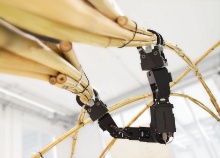Task and Motion Planning for Collaborative Robotic Construction with Irregular Materials
Before the industrial revolution, humans used their intuition of material behavior to collaboratively build highly sustainable structures with low precision tools and natural materials. As the industrial revolution made its mark and the precision of our tools grew, so did the logic with which we design and build. This is directly reflected in the current usage of robots in the construction industry which are often larger than the building artefact, and are limited to working with predictable and standardized materials, despite their generally low level of sustainability.
Advances in research are currently validating a shift towards distributed and mobile material-robot construction systems. This entails distributed robotic systems being co-designed directly with the material systems they employ, leading to zero waste construction systems. Much like pre-industrial construction, the potential of these systems lies in their adaptability and robustness, allowing them to operate in dynamic environments and to collaborate in large teams.
This project intends to extend this line of investigation by combining research on Architecture, Engineering & Construction (AEC) and AI to the problem of building with natural irregular materials, specifically bamboo. In particular, we will investigate how to combine the adaptiveness of reinforcement learning (RL) with the long-horizon capabilities of Logic-Geometric Programming (LGP) to form a task and motion planning strategy that can solve such collaborative and nonlinear construction problems. We believe that combining the strengths of distributed material-robot systems and those of AI methods such as LGP and RL are essential in unlocking natural irregular materials for use in more sustainable robotic construction.
Therefore the scope of this project entails the co-development of: (1) a collaboration-centric material-robot construction system, (2) a planning algorithm for sequencing tasks from construction artefacts, (3) a system identification methodology for learning material representations, (4) the implementation and evaluation of reinforcement learning (RL) and Logic-Geometric Programming (LGP) in task and motion planning for the sequenced assembly tasks.
PROJECT TEAM
ICD Institute for Computational Design and Construction, University of Stuttgart
Nicolas Kubail Kalousdian, Samuel Leder, Prof. A. Menges
Learning and Intelligent Systems Research Lab, Technische Universität Berlin
Prof. Marc Toussaint
PROJECT FUNDING
Cyber Valley Research Fund - CyVy-RF-2021-18
RELATED PUBLICATIONS
Łochnicki, G., Kubail Kalousdian, N., Leder, S., Maierhofer, M., Wood, D., Menges, A. "Co-Designing Material-Robot Construction Behaviors: Teaching distributed robotic systems to leverage active bending for light-touch assembly of bamboo bundle structures", in ACADIA - Realignments: Toward Critical Computation [Proceedings of the ACADIA Conference 2021].
N. Kubail Kalousdian, G. Łochnicki, V. Hartmann, S. Leder, O. S. Oguz, A. Menges, M. Toussaint, "Learning Robotic Manipulation of Natural Materials with Variable Properties for Construction Tasks", in IEEE Robotics and Automation Letters. [Submitted: September 2021]


